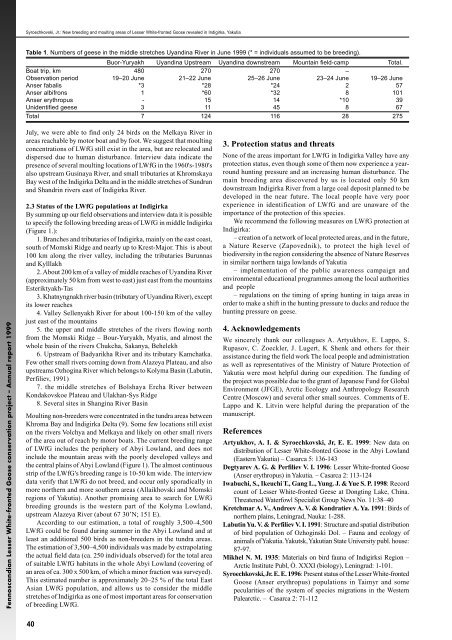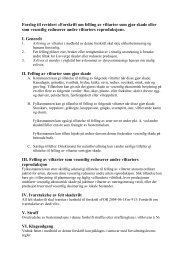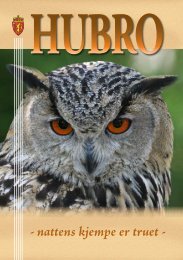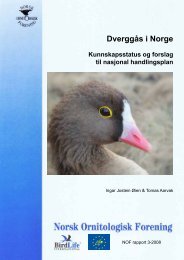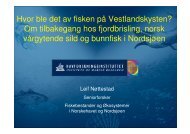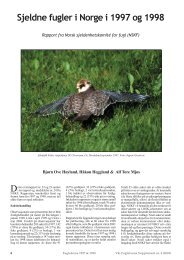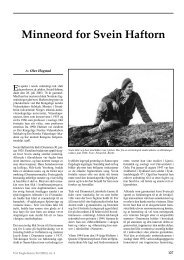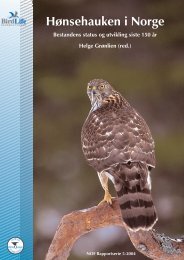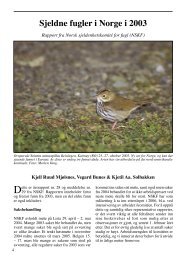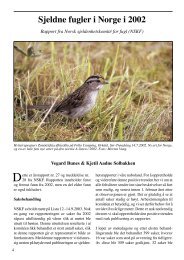Fennoscandian Lesser White-fronted Goose conservation project ...
Fennoscandian Lesser White-fronted Goose conservation project ...
Fennoscandian Lesser White-fronted Goose conservation project ...
Create successful ePaper yourself
Turn your PDF publications into a flip-book with our unique Google optimized e-Paper software.
<strong>Fennoscandian</strong> <strong>Lesser</strong> <strong>White</strong>-<strong>fronted</strong> <strong>Goose</strong> <strong>conservation</strong> <strong>project</strong> – Annual report 1999<br />
Syroechkovski, Jr.: New breeding and moulting areas of <strong>Lesser</strong> <strong>White</strong>-<strong>fronted</strong> <strong>Goose</strong> revealed in Indigirka, Yakutia<br />
Table 1. Numbers of geese in the middle stretches Uyandina River in June 1999 (* = individuals assumed to be breeding).<br />
Buor-Yuryakh Uyandina Upstream Uyandina downstream Mountain field-camp Total.<br />
Boat trip, km 480 270 270 –<br />
Observation period 19–20 June 21–22 June 25–26 June 23–24 June 19–26 June<br />
Anser fabalis *3 *28 *24 2 57<br />
Anser albifrons 1 *60 *32 8 101<br />
Anser erythropus - 15 14 *10 39<br />
Unidentified geese 3 11 45 8 67<br />
Total 7 124 116 28 275<br />
July, we were able to find only 24 birds on the Melkaya River in<br />
areas reachable by motor boat and by foot. We suggest that moulting<br />
concentrations of LWfG still exist in the area, but are relocated and<br />
dispersed due to human disturbance. Interview data indicate the<br />
presence of several moulting locations of LWfG in the 1960's-1980's<br />
also upstream Gusinaya River, and small tributaries at Khromskaya<br />
Bay west of the Indigirka Delta and in the middle stretches of Sundrun<br />
and Shandrin rivers east of Indigirka River.<br />
2.3 Status of the LWfG populations at Indigirka<br />
By summing up our field observations and interview data it is possible<br />
to specify the following breeding areas of LWfG in middle Indigirka<br />
(Figure 1.):<br />
1. Branches and tributaries of Indigirka, mainly on the east coast,<br />
south of Momski Ridge and nearly up to Krest-Major. This is about<br />
100 km along the river valley, including the tributaries Burunnas<br />
and Kylllakh<br />
2. About 200 km of a valley of middle reaches of Uyandina River<br />
(approximately 50 km from west to east) just east from the mountains<br />
Esteriktyakh-Tas<br />
3. Khatnyngnakh river basin (tributary of Uyandina River), except<br />
its lower reaches<br />
4. Valley Sellenyakh River for about 100-150 km of the valley<br />
just east of the mountains<br />
5. the upper and middle stretches of the rivers flowing north<br />
from the Momski Ridge – Bour-Yuryakh, Myatis, and almost the<br />
whole basin of the rivers Chukcha, Sakanya, Behelekh<br />
6. Upstream of Badyarikha River and its tributary Kamchatka.<br />
Few other small rivers coming down from Alazeya Plateau, and also<br />
upstreams Ozhogina River which belongs to Kolyma Basin (Labutin,<br />
Perfiliev, 1991)<br />
7. the middle stretches of Bolshaya Ercha River between<br />
Kondakovskoe Plateau and Ulakhan-Sys Ridge<br />
8. Several sites in Shangina River Basin<br />
Moulting non-breeders were concentrated in the tundra areas between<br />
Khroma Bay and Indigirka Delta (9). Some few locations still exist<br />
on the rivers Volchya and Melkaya and likely on other small rivers<br />
of the area out of reach by motor boats. The current breeding range<br />
of LWfG includes the periphery of Abyi Lowland, and does not<br />
include the mountain areas with the poorly developed valleys and<br />
the central plains of Abyi Lowland (Figure 1). The almost continuous<br />
strip of the LWfG's breeding range is 10-50 km wide. The interview<br />
data verify that LWfG do not breed, and occur only sporadically in<br />
more northern and more southern areas (Allaikhovski and Momski<br />
regions of Yakutia). Another promising area to search for LWfG<br />
breeding grounds is the western part of the Kolyma Lowland,<br />
upstream Alazeya River (about 67 30’N; 151 E).<br />
According to our estimation, a total of roughly 3,500–4,500<br />
LWfG could be found during summer in the Abyi Lowland and at<br />
least an additional 500 birds as non-breeders in the tundra areas.<br />
The estimation of 3,500–4,500 individuals was made by extrapolating<br />
the actual field data (ca. 250 individuals observed) for the total area<br />
of suitable LWfG habitats in the whole Abyi Lowland (covering of<br />
an area of ca. 300 x 500 km, of which a minor fraction was surveyed).<br />
This estimated number is approximately 20–25 % of the total East<br />
Asian LWfG population, and allows us to consider the middle<br />
stretches of Indigirka as one of most important areas for <strong>conservation</strong><br />
of breeding LWfG.<br />
40<br />
3. Protection status and threats<br />
None of the areas important for LWfG in Indigirka Valley have any<br />
protection status, even though some of them now experience a yearround<br />
hunting pressure and an increasing human disturbance. The<br />
main breeding area discovered by us is located only 50 km<br />
downstream Indigirka River from a large coal deposit planned to be<br />
developed in the near future. The local people have very poor<br />
experience in identification of LWfG and are unaware of the<br />
importance of the protection of this species.<br />
We recommend the following measures on LWfG protection at<br />
Indigirka:<br />
– creation of a network of local protected areas, and in the future,<br />
a Nature Reserve (Zapovednik), to protect the high level of<br />
biodiversity in the region considering the absence of Nature Reserves<br />
in similar northern taiga lowlands of Yakutia<br />
– implementation of the public awareness campaign and<br />
environmental educational programmes among the local authorities<br />
and people<br />
– regulations on the timing of spring hunting in taiga areas in<br />
order to make a shift in the hunting pressure to ducks and reduce the<br />
hunting pressure on geese.<br />
4. Acknowledgements<br />
We sincerely thank our colleagues A. Artyukhov, E. Lappo, S.<br />
Rupasov, C. Zoeckler, J. Lugert, K Shenk and others for their<br />
assistance during the field work The local people and administration<br />
as well as representatives of the Ministry of Nature Protection of<br />
Yakutia were most helpful during our expedition. The funding of<br />
the <strong>project</strong> was possible due to the grant of Japanese Fund for Global<br />
Environment (JFGE), Arctic Ecology and Anthropology Research<br />
Centre (Moscow) and several other small sources. Comments of E.<br />
Lappo and K. Litvin were helpful during the preparation of the<br />
manuscript.<br />
References<br />
Artyukhov, A. I. & Syroechkovski, Jr, E. E. 1999: New data on<br />
distribution of <strong>Lesser</strong> <strong>White</strong>-<strong>fronted</strong> <strong>Goose</strong> in the Abyi Lowland<br />
(Eastern Yakutia) – Casarca 5: 136-143<br />
Degtyarev A. G. & Perfiliev V. I. 1996: <strong>Lesser</strong> <strong>White</strong>-<strong>fronted</strong> <strong>Goose</strong><br />
(Anser erythropus) in Yakutia. – Casarca 2: 113-124<br />
Iwabuchi, S., Ikeuchi T., Gang L., Yung. J. & Yue S. P. 1998: Record<br />
count of <strong>Lesser</strong> <strong>White</strong>-<strong>fronted</strong> Geese at Dongting Lake, China.<br />
Threatened Waterfowl Specialist Group News No. 11:38–40<br />
Kretchmar A. V., Andreev A. V. & Kondratiev A. Ya. 1991: Birds of<br />
northern plains, Leningrad, Nauka: 1-288.<br />
Labutin Yu. V. & Perfiliev V. I. 1991: Structure and spatial distribution<br />
of bird population of Ozhoginski Dol. – Fauna and ecology of<br />
animals of Yakutia. Yakutsk, Yakutian State University publ. house:<br />
87-97.<br />
Mikhel N. M. 1935: Materials on bird fauna of Indigirksi Region –<br />
Arctic Institute Publ, Ò. XXXI (biology), Leningrad: 1-101.<br />
Syroechkovski, Jr. E. E. 1996: Present status of the <strong>Lesser</strong> <strong>White</strong>-<strong>fronted</strong><br />
<strong>Goose</strong> (Anser erythropus) populations in Taimyr and some<br />
pecularities of the system of species migrations in the Western<br />
Palearctic. – Casarca 2: 71-112


